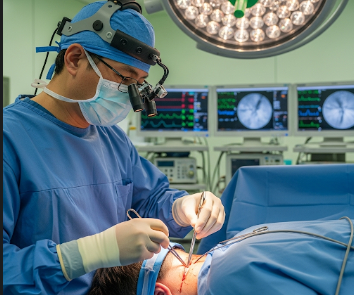Overview
A cervical laminectomy is a surgical procedure performed to relieve pressure on the spinal cord or nerve roots in the neck (cervical spine). This pressure is often caused by spinal stenosis, herniated discs, bone spurs, or tumors, which can lead to neck pain, numbness, weakness, or impaired arm function.
In South Korea, cervical laminectomy is performed using advanced microsurgical techniques and minimally invasive approaches, ensuring enhanced precision, reduced complications, and faster recovery. Korean neurosurgeons are known for their expertise in spinal surgery and post-operative rehabilitation programs, making it a preferred destination for patients requiring spinal decompression.
What is Cervical Laminectomy?
Cervical laminectomy involves removing a portion of the vertebral bone (lamina) in the neck to create more space for the spinal cord and nerves.
Types of cervical laminectomy include:
- Open cervical laminectomy: Traditional method with a larger incision to access the spine.
- Minimally invasive cervical laminectomy: Smaller incision with endoscopic assistance, reducing tissue damage and speeding recovery.
- Laminectomy with fusion: Often performed when spinal stability needs reinforcement using plates, screws, or bone grafts.
This procedure is typically indicated for patients with severe nerve compression or spinal cord dysfunction.
What are the Benefits?
Cervical laminectomy offers multiple functional and quality-of-life benefits:
✔ Relief from chronic neck pain and stiffness.
✔ Alleviation of nerve compression symptoms such as numbness, tingling, or weakness in the arms and hands.
✔ Improved spinal cord function and mobility.
✔ Prevention of further neurological damage.
✔ In South Korea, minimally invasive techniques reduce recovery time and postoperative complications.
Procedure Details
1) How should I prepare for Cervical Laminectomy?
- Medical evaluation: MRI, CT scans, and X-rays to assess spinal anatomy and compression.
- Medication review: Blood thinners may need to be paused before surgery.
- Fasting: Usually required 6–8 hours before anesthesia.
- Preoperative planning: Discuss anesthesia type, surgical approach, and potential fusion if needed.
- Arrange post-operative support: Assistance with mobility and daily activities during recovery.
Korean hospitals provide comprehensive preoperative consultations and imaging-based surgical planning to ensure optimal outcomes.
2) What happens during the procedure Cervical Laminectomy?
- Surgery is performed under general anesthesia.
- An incision is made at the back of the neck to expose the affected vertebrae.
- The lamina (portion of vertebral bone) is removed to relieve pressure on the spinal cord and nerve roots.
- If spinal stability is compromised, fusion or instrumentation may be performed.
- The incision is closed with sutures or staples, and the area is bandaged.
The procedure generally lasts 2–4 hours, depending on the number of levels involved and whether fusion is required.
Minimally invasive Korean techniques reduce muscle disruption and bleeding, leading to quicker recovery.
3) What happens after a Cervical Laminectomy?
- Patients are monitored in a post-anesthesia care unit until alert and stable.
- Pain is managed with medication; a soft cervical collar may be used for support.
- Physical therapy is typically initiated to restore neck mobility and strength.
- Most patients stay 2–5 days in the hospital, depending on procedure complexity.
- Full recovery and return to normal activities usually take 6–12 weeks, with gradual improvement in neurological symptoms.
Korean spinal centers provide structured rehabilitation programs including physiotherapy, posture correction, and ergonomic education.
Risks / Benefits
Potential Risks:
- ➤ Infection at the surgical site
- ➤ Bleeding or hematoma
- ➤ Nerve or spinal cord injury (rare but serious)
- ➤ Persistent pain or stiffness
- ➤ Complications from anesthesia
- ➤ Fusion-related issues (if fusion performed)
Major Benefits:
- ✔ Significant relief from neck and arm pain
- ✔ Restoration of nerve function and mobility
- ✔ Prevention of long-term neurological deficits
- ✔ Minimized recovery time with minimally invasive techniques
- ✔ High success rates in South Korean neurosurgery centers
Recovery and Outlook
- Immediate post-op: Pain management, cervical support, and monitoring neurological function.
- First 2 weeks: Limited neck movement, gradual resumption of light activities.
- 4–6 weeks: Physical therapy progresses to improve strength and flexibility.
- 3–6 months: Most patients regain near-normal neck mobility and nerve function.
In South Korea, expert neurosurgeons and rehabilitation specialists provide continuous follow-up to ensure safe recovery and optimal functional outcomes.
When To Call the Doctor
Contact your surgeon immediately if you experience:
- ➤ Severe or worsening neck pain
- ➤ Numbness, tingling, or weakness in arms or hands
- ➤ Loss of bladder or bowel control
- ➤ Fever, redness, or signs of infection at the incision site
- ➤ Unusual swelling or discharge
Best Korea Option / Process
South Korea is considered a world leader in spinal surgery, offering:
- Highly experienced neurosurgeons and orthopedic spine specialists
- Advanced imaging and minimally invasive surgical tools
- Customized surgical planning using 3D spinal mapping
- Structured rehabilitation programs for faster and safer recovery
- Comprehensive care for international patients, including accommodation and translation services
- Affordable treatment options compared to Western countries without compromising quality
Top hospitals and clinics for cervical laminectomy in Korea:
- Samsung Medical Center
- Asan Medical Center, Seoul
- Seoul National University Hospital
- Severance Hospital (Yonsei University Health System)













